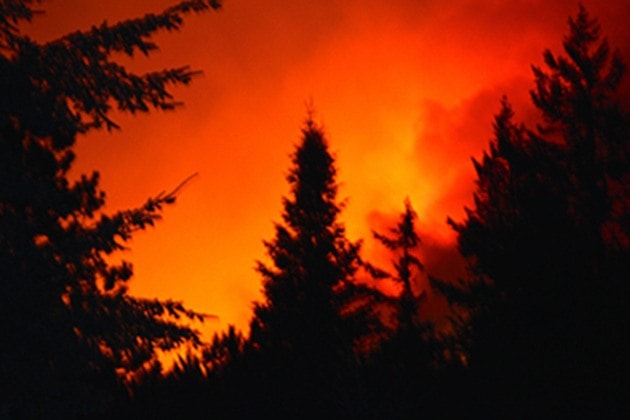A forest fire in West Arm Provincial Park could destroy Nelson’s water supply, and it would cost millions to restore it.
The fire could start anywhere: in the park, on rural private land, on crown land, or in the city.
So the City of Nelson, the Regional District of Central Kootenay (RDCK) and BC Parks are trying to figure out how to protect us all from something like last year’s Sitkum fire, especially one that threatens the water supply or other critical infrastructure.
They presented their draft Community Wildfire Protection Plan to the public at an open house yesterday. The session was led by consultants John Cathro and Bruce Blackwell. They think action is urgently needed.
“In my opinion,” Blackwell said, “this is in the top-10 areas of the province for the next big fire, this is right up there.
“I am not fear-mongering. I would really like to see us get on with this work so when that fire does come, we have a chance.”

Consultant John Cathro (right) discusses wildfire protection with rural Nelson landowner Terence Buie.
One of the components of the plan is fuel treatment. That means modifying forest vegetation by retaining large dominant trees but thinning from below by removing small trees. Then, prune the retained trees from the ground up to increase the height to the crown.
Next, remove all wood debris on the ground. The result: a forest of large trees with no underbrush, small trees, or debris.
Cathro and Blackwell presented a map (pictured below) of an area between Queens Bay and the Slocan Junction including West Arm Park showing many areas they consider to be at high risk.
“High risk,” Cathro said, “is defined fundamentally by two things: how much forest fuel is there — how dense is the forest, how much debris and branches on the ground — and second, the proximity to residences and critical infrastructure.”
He defined critical infrastructure as water systems, communication lines, transmission lines, transportation routes, and facilities such as hospitals and fire halls.
Cathro said the map shows “the absolute priority areas from a strategic perspective on the landscape. Where do you need to reduce the risk if you want to protect communities from wildfire?”
The wildfire plan aims at doing vegetation management in those areas as soon as possible or over the next 10 years, Blackwell said.

“At the pace we are at right now, we don’t even come close to those targets, but this plan makes you shovel ready when funds are available.”
He explained that the city, the regional district and BC Parks will start applying for funding after they have approved the plan.
“The Union of BC Municipalities has a funding program and there is a new program called the Forest Enhancement Society and funding is available there to start the work on these plans.”
He said the Nelson area would be competing with other areas of the province for the funding.
The wildfire protection plan does not include private land. Most of the land surrounding Nelson is privately owned, and Blackwell told the Star in June that some of it is dangerously neglected.
“All we need is one house fire on a piece of private property where there is a lot of fuel, and it is going to spread to the greater landscape,” he said.
The job of the three government agencies is to educate landowners and make them aware of the risk, Blackwell said, but they can’t force them to act.
Nelson has been doing vegetation management on forests in its boundaries over the past few years at the cemetery, in Rosemont Park, and around a retirement home in Fairview. The RDCK identified 20,000 hectares for treatment in 2007 and has so far done 290 hectares.
In addition to fuel treatment, the wildfire plan includes educational components on how to protect structures, with detailed information on how fires spread from forest to urban areas and vice-versa. It also addresses training for emergency readiness.
